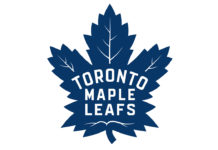The reality is that it was always going to be this way.
Since losing out in the first round again, the Maple Leafs have made it abundantly clear that they believe in the core and have very little interest in moving out any of its pieces. Kyle Dubas is pretty much betting his job on it at this point:
Fairly simply, I understand that some may look at it and say this group hasn’t gotten it done, thus why there has to be changes. For better or worse, I believe in this group. I believe that they are going to get it done and that they are going to win… I am comfortable with it. I believe we are going to see the best version of this group next season that we have seen yet. I am willing to bet everything on that.
With all the big contracts on the books and a locked-in group of top-four defensemen to go along with them, there was simply never going to be the cap space available to add multiple significant players across the team’s forward and goaltending positions.
The Leafs rightly prioritized adding a goalie at the start of free agency, ultimately inking a three-year deal to bring in Petr Mrazek (Alec provided the instant analysis here). Goalies are magic beans, but there are more than a few positives with this signing.
Mrazek does own a good track record in the league, has strung together some strong seasons, and he’s coming from a team that is also strong defensively, so he’s used to this kind of style of play and environment where he simply has to be solid in a controlled defensive system.
If the Leafs are able to continue their strong defensive play from last season, an average goaltending performance will lead to above-average results. That’s quite simply all they need (during the regular season, anyway).
Mrazek has also been part of a successful 1A/1B tandem before, most notably with Curtis McElhinney in the 2018-19 season — where Mrazek played 40 games and McElhinney played 33 — and also with Jimmy Howard a few years earlier. He is used to this kind of setup.
Ultimately, the Leafs are still banking on Jack Campbell’s ability to build on last season. If he doesn’t, they now have another netminder that they can feel comfortable about handing the net to if need be. As with any 1A/1B tandem, the coaching staff will have to be strategic in managing the platoon while keeping them both involved and engaged. The plan going into the season isn’t to hand one of the two goalies 60 starts.
Without looking too far into the future, you would have to think that Campbell — who has one year left on his contract — splitting starts throughout the season should keep his price tag lower, even if he does produce a strong campaign. With Mrazek signing for three years of term at $3.8 million AAV, the Leafs can sign another goalie to partner him with at a similar-ish number while spending around $7-8 million on goaltending in total.
The average salary of a starting goalie last season was roughly $5.5 million. There are nine goalies in the league as of this writing making $6+ million — nearly a third of the league — and when we add in a backup, the Leafs’ goalies could feasibly come in around that cap allotment. They’ve situated themselves nicely in terms of the short- and medium-term outlook in net (save for Campbell producing some sort of playoff run that puts himself in a position to cash in big-time, in which case they’d likely have to decide one way or the other — file it under, “a good problem to have”).
With goaltending locked in, the remaining question basically boils down to how the Leafs will fill out their forward group. Barring something shaking out with Morgan Rielly, the team’s top four defense is set, and they made sure to protect it in the expansion draft.
The Leafs also have Travis Dermott, Rasmus Sandin, and Timothy Liljegren on the depth chart, and with the prices on depth defensemen today, it makes little sense to overpay as opposed to simply giving the young players the opportunity to play NHL games. There will be growing pains, but it’s a fair rationale, and they could easily move defensemen around to protect the young players (such as splitting up Jake Muzzin and Justin Holl in order to pair them with a young partner each).
The forward position is a different story. The Leafs added four players on the first day of free agency. If we’re being honest, though, Michael Bunting and David Kampf are the two additions of note.
In a vacuum, you can’t argue with the Bunting deal. The contract can be fully buried in the AHL, he has a good track record of production in the AHL, and he showed well in the NHL this season, albeit while riding a sky-high shooting percentage. Keep in mind, though, that this is not a luxury signing for the Leafs – they actually do need Bunting to pan out, and if he isn’t, it puts more pressure on players such as Pierre Engvall, Ilya Mikheyev, and Wayne Simmonds to be more productive than they’re probably able to be.
One of the above-mentioned would likely have to play somewhere above where they should be in the lineup. At this point, the Leafs don’t really have the depth in the organization for the organization to shrug its shoulders should Bunting not work out.
While I understand the sentiment of “great deal” and “great upside” — both of which are true — the pressures and realities of the situation for the Leafs as a whole mean that this will cause a domino effect of depth issues if it doesn’t work out. There is a real risk to this signing. It’s disingenuous to suggest otherwise.
That brings us to the second signing of note at forward: David Kampf. I already wrote about his faceoff prowess and noted his shorthanded time on ice (they need to somehow fill the minutes Hyman played there). Adding a checking center is a good thing, and Kampf is a good one of those.
Long-time readers will know that this is something I’ve pointed out as a need for years. A hypothetical line of Engvall – Kampf – Mikheyev should do quite well in that role (Engvall and Mikheyev already were!).
The problem at the moment is the lack of scoring and the overall margin of error. The Leafs’ forwards that can’t score — or that they can’t trust to score — go well beyond what might serve as their checking line. As it stands, you might draw up the Leafs’ lines to look something like this:
Bunting – Matthews – Marner
Kerfoot – Tavares – Nylander
Engvall – Kampf – Mikheyev
Simmonds – Brooks – Spezza
If Bunting is more Jimmy Vesey-like than he is even Alex Galchenyuk-like, the Leafs already have a big problem on their hands. It’s not like there is much in the way of scoring on the bottom two lines beyond Jason Spezza other than a hope and a prayer. If someone struggles in the top six, who is seriously going to compete with them for ice time and more scoring opportunities?
Even if the Leafs start moving players around and spreading out their top four forwards across three lines, in basically every scenario/combination, they will look at the forward lines and think either, “That doesn’t look right,” or, “You can’t attach this non-scorer with a top player and expect much.”
From there, we start getting into the “I hope Nick Robertson emerges” territory and find ourselves wondering if Adam Brooks could break out. Those are fine enough theories to wonder about, sure, but for a team that needs to win in the playoffs or else major changes are coming? It’s a big, big ask, and a plan comprised of nothing more than hope.
At this point, the Leafs have lost Zach Hyman up front, Alex Galchenyuk remains a free agent (I wouldn’t include Nick Foligno in this because he barely played), and they’ve signed David Kampf and Michael Bunting. Putting the cap considerations aside, there is no way to spin this as a tangible improvement of the actual roster.
Additional Thoughts
– When Kevin Woodley joined the podcast a few weeks ago, he pointed out that when a team acquires a goalie, it should make sure that the style of play aligns with the goaltender in order to create an environment for success. I think the Leafs can at least rest easy on this one having hired the former Hurricanes assistant coach to run their defense and penalty kill – the two factors that would impact a goalie the most.
– We spoke about the Leafs’ lack of scoring depth as things currently stand, but one additional forward of note would really give them some options to suddenly start playing around with and take the pressure off of Bunting needing to pan out. Let’s just say, for argument’s sake, the Leafs bring back Galchenyuk:
Galchenyuk – Matthews – Marner
Kerfoot – Tavares – Nylander
Engvall – Kampf – Mikheyev
Bunting – Spezza – Simmonds
Brooks
Suddenly, it makes a lot more sense. When Keefe inevitably becomes upset with Engvall and sits him, he can simply move Simmonds up (he liked him in that checking role in the playoffs) and insert Brooks to center Bunting and Spezza in a scoring role. If Bunting were to take off and prove to be a real late bloomer, suddenly the Leafs can move him up and down the lineup.
– On Bunting: He is quite good in front of the net and played in that spot on the power play when the Coyotes put him out there. It was something former Coyotes head coach Rick Tocchet noted as well. With Hyman gone, there is an opening for that type of role on one of the Leafs’ power-play units.
– It will be interesting to watch who the Leafs use on the penalty kill with Hyman and even Foligno/Nash gone. Marner, Mikheyev, and presumably Kerfoot should still be on the unit. The guess is Kampf is that is a regular — for faceoffs alone if nothing else. I wonder if Engvall gets back in there now, too.
– There has been lots of talk around Nick Robertson given the Leafs’ scoring depth issues. While I understand it, he has only played 21 games in the AHL plus another 10 in the NHL. The kid is 19. I’d rather give him half of a proper season in the AHL (at minimum) versus rushing him along. When calling up young players, you want it to be for good because they are ready as opposed to yoyoing them back and forth.
– I suppose if Alex Galchenyuk is offered extra years/money, he kind of has to take it, but he appeared to have found a bit of a home in Toronto, and he is still very much re-establishing himself in the league after playing for seven different organizations and going unclaimed through waivers. It seems kind of crazy for him, personally speaking, to even consider leaving, all things being equal. There is opportunity galore alongside elite players on the Leafs right now.
– I would have liked to have brought Nick Foligno back on the cheap, but $3.8 million AAV for two years is not cheap, unfortunately.
– It appears the Leafs are done on defense and have added some veteran depth in Alex Biega just in case. Eyes should turn to a Morgan Rielly contract now. If the Leafs were going to trade him — and I’m sure they still can if they wanted to — the logical time to do it has now passed. I’ll just keep reiterating this until my face turns blue: You can’t lose him for free.
– I understand the Leafs saying no to a sixth from Edmonton in a Zach Hyman sign-and-trade, but Darren Dreger reported that the Leafs said no to an offer of two draft picks, including one in the first five rounds. Let’s say it was actually a fifth-rounder along with a sixth. I’m surprised the Leafs didn’t take it.
I understand that the odds of either pick panning out are still very low and it’s not much of an upgrade on the original offer, but the Leafs more or less just punted on an entire draft class this summer. They drafted three times total and once in the first four rounds. It’s probably not getting talked about enough, but they barely participated in the 2021 draft, and that’s usually the kind of thing we point to in five years’ time and say, “This really hurt.”
If none of the three players pan out, the Leafs will really feel it as an organization. Collecting two extra lottery tickets for a player otherwise walking for free when the Leafs still very much need to load up their prospect pool is not exactly a bad bit of business. You should rarely be in this situation in the first place (a good free agent walking for free), so I’m not sure it’s even a matter of precedent for the years to come.
– Tough sledding in the Atlantic so far. Tampa Bay lost their third line but retained their entire top six, players like Mathieu Joseph and Ross Colton are ready to be promoted, they brought back Zach Bogosian to round out their defense, and they still have the best goalie in the world. Boston completely retooled, adding a number of useful players in Foligno, Erik Haula, and Tomas Nosek, as well as a starter-calibre goalie. Florida acquired Sam Reinhart.
Those are three really good teams, plus the Montreal Canadiens are still lurking (although I do think they actually got worse with the loss of Phillip Danault). It’s going to be tough sledding for the Leafs. This definitely isn’t the all-Canadian division anymore.

































